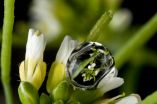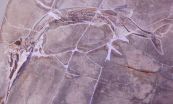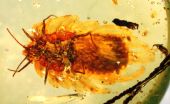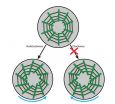Scientists discover why flowers bloom earlier in a warming climate
2015-03-31
(Press-News.org) Scientists at the John Innes Centre have discovered why the first buds of spring come increasingly earlier as the climate changes.
Dr Steven Penfield at the JIC found that plants have an ideal temperature for seed set and flower at a particular time of year to make sure their seed develops just as the weather has warmed to this 'sweet spot' temperature.
Dr Penfield, working with Dr Vicki Springthorpe at the University of York, found the sweet spot for the model plant Arabidposis thaliana is between 14-15?C. Seeds that develop in temperatures lower than 14?C will almost always remain dormant and fail to germinate. This allows the mother plant to produce seeds with different growth strategies, increasing the chances that some of her progeny will successfully complete another generation.
As the climate changes the sweet spot for seeds comes earlier in the year, so first flowers bloom correspondingly earlier too.
The research which received funding from the Biotechnology and Biological Research Council (BBSRC) and is published in eLife today, used computer models to understand the growth strategy of Arabidopsis thaliana. The underlying principle of a very sensitive temperature sweet spot is likely to apply to many flowering plants. This would mean that certain plants have different flowering times due to different but equally narrow temperature sensitivity windows.
Dr Penfield said: "We found that setting seed at the correct temperature is vital to ensure normal germination. It seems that plants aim to flower not at a particular time of year, but when the optimal temperature for seed set is approaching. If the climate warms plants are clever enough to recognise this and adjust their flowering time accordingly and it feels like spring comes earlier in the year."
INFORMATION:
Notes to editors
1. If you have any questions or would like to interview Dr Penfield please contact:
Geraldine Platten
Communications Manager
John Innes Centre & The Sainsbury Laboratory
t: 01603 450 238
e: geraldine.platten@jic.ac.uk
2. A PDF of the eLife paper and images to accompany this press release can be found at:http://bit.ly/19Fa0YX
3. About the John Innes Centre
Our mission is to generate knowledge of plants and microbes through innovative research, to train scientists for the future, to apply our knowledge of nature's diversity to benefit agriculture, the environment, human health and well-being, and engage with policy makers and the public.
To achieve these goals we establish pioneering long-term research objectives in plant and microbial science, with a focus on genetics. These objectives include promoting the translation of research through partnerships to develop improved crops and to make new products from microbes and plants for human health and other applications. We also create new approaches, technologies and resources that enable research advances and help industry to make new products. The knowledge, resources and trained researchers we generate help global societies address important challenges including providing sufficient and affordable food, making new products for human health and industrial applications, and developing sustainable bio-based manufacturing.
This provides a fertile environment for training the next generation of plant and microbial scientists, many of whom go on to careers in industry and academia, around the world.
The John Innes Centre is strategically funded by the Biotechnology and Biological Sciences Research Council (BBSRC). In 2013-2014 the John Innes Centre received a total of £31.4 million from the BBSRC.
About BBSRC
The Biotechnology and Biological Sciences Research Council (BBSRC) invests in world-class bioscience research and training on behalf of the UK public. Our aim is to further scientific knowledge, to promote economic growth, wealth and job creation and to improve quality of life in the UK and beyond.
Funded by Government, BBSRC invested over £484M in world-class bioscience in 2013-14. We support research and training in universities and strategically funded institutes. BBSRC research and the people we fund are helping society to meet major challenges, including food security, green energy and healthier, longer lives. Our investments underpin important UK economic sectors, such as farming, food, industrial biotechnology and pharmaceuticals.
For more information about BBSRC, our science and our impact see: http://www.bbsrc.ac.uk
For more information about BBSRC strategically funded institutes see: http://www.bbsrc.ac.uk/institutes
[Attachments] See images for this press release:

ELSE PRESS RELEASES FROM THIS DATE:
2015-03-31
Saurichthys is a predatory fish characterized by a long thin body and a sharply pointed snout with numerous teeth. This distinctive ray-finned fish lived in marine and freshwater environments all over the world 252-201 million years ago during the Triassic period. Two new species of this extinct fish have been discovered by paleontologists at the University of Zurich, working in collaboration with researchers in Germany and China. The first species, «Saurichthys breviabdominalis», is named for its relatively short body and the second, «Saurichthys rieppeli», ...
2015-03-31
Darwin's evolutionary theory predicts survival of the fittest. So why do different survival tactics co-exist, if evolution should always favour the winning strategy?
To answer that question scientists at the Universities of Bath and Manchester have been studying a single-celled amoeba, also known as slime mould, which displays certain behaviours that have been labelled as "cheating" or "cooperating".
In a study, published in the prestigious journal Current Biology, the team found that cheaters don't necessarily win in terms of overall survival, suggesting that biologists ...
2015-03-31
Scientists at the University of Bonn, together with colleagues from China, UK and Poland, have described the oldest evidence of brood care in insects: it is in a female scale insect with her young that is encased in amber as a fossil. The approximately100-million-year-old "snapshot" from the Earth's history shows the six millimetre long tiny insect with a wax cocoon, which protected the eggs from predators and drying out plus associated young nymphs. The researchers are now presenting their results in the respected journal eLIFE.
The small female insect with the waxy ...
2015-03-31
Face recognition security on smartphones can be significantly improved if users store an 'average' photo of themselves, according to new research by scientists at the University of York.
A research team led by Dr David Robertson, of the Department of Psychology's FaceVar laboratory at York, found that combining different pictures of the user, rather than a single 'target' image, leads to much better recognition across all kinds of daily settings. The research is published in the journal PLOS ONE.
The researchers examined the performance of the 'face unlock' system ...
2015-03-31
Researchers at the Mechanobiology Institute (MBI) at the National University of Singapore have discovered that the inherent 'handedness' of molecular structures directs the behaviour of individual cells and confers them the ability to sense the difference between left and right. This is a significant step forward in the understanding of cellular biology. This discovery was published in Nature Cell Biology on 23 March 2015.
Cellular decision making
Our bodies are made up of hundreds of different types of cells, each of which performs a unique and highly specialized ...
2015-03-31
Researchers from the UK and Malaysia have detected a human fingerprint deep in the Borneo rainforest in Southeast Asia. Cold winds blowing from the north carry industrial pollutants from East Asia to the equator, with implications for air quality in the region. Once there, the pollutants can travel higher into the atmosphere and impact the ozone layer. The research is published today in Atmospheric Chemistry and Physics, an open access journal of the European Geosciences Union (EGU).
Rainforests are often associated with pure, unpolluted air, but in Borneo air quality ...
2015-03-31
WASHINGTON-- The Society for Public Health Education (SOPHE) proudly announces the publication of a Health Education & Behavior (HE&B) supplement devoted to the latest research and practice on policy and environmental approaches to foster healthy communities. The April 2015 supplement, "The Evidence for Policy and Environmental Approaches to Promoting Health," comprises a dozen peer-reviewed articles and two perspectives examining the state-of-the-evidence on what's working and what's needed at the community, institutional and societal levels to promote good health across ...
2015-03-31
A world first study revealing the presence of two antibodies in a sub-group of children experiencing their first episode of psychosis affirms a longstanding recognition that auto-immune disorders play a significant role in psychiatric illness.
Antibodies defend the body against bacterial, viral, and other invaders but sometimes the body makes antibodies that attack healthy cells. In these cases, autoimmune disorders develop. These include conditions such as multiple sclerosis (MS), rheumatoid arthritis and Type 1 diabetes.
This 'immune hypothesis' is supported by new ...
2015-03-31
Almost every pig carries harmless strains of the S. suis bacterium - such strains are known as 'commensal' strains. However, a more virulent group of strains of the bacteria also exist, which cause disease in pigs worldwide and are a major driver of antibiotic use for prevention. Increasingly, this group of strains is also implicated in serious human diseases such as meningitis and septicaemia.
In order to understand the genetic basis of disease in S. suis, an international study, led by the Bacterial Respiratory Diseases of Pigs-1 Technology (BRaDP1T) consortium, examined ...
2015-03-31
New research from the University of Toronto has scientists re-thinking how a lethal fungus grows and kills immune cells. The study hints at a new approach to therapy for Candida albicans, one of the most common causes of bloodstream infections.
Previously, scientists thought that Candida albicans spread by changing from a single, round cell to a long string of cells, or filaments. They thought this shape change allowed the fungus to move through the bloodstream and let its filaments penetrate tissues and destroy immune cells.
But the new study, published today in Nature ...
LAST 30 PRESS RELEASES:
[Press-News.org] Scientists discover why flowers bloom earlier in a warming climate





